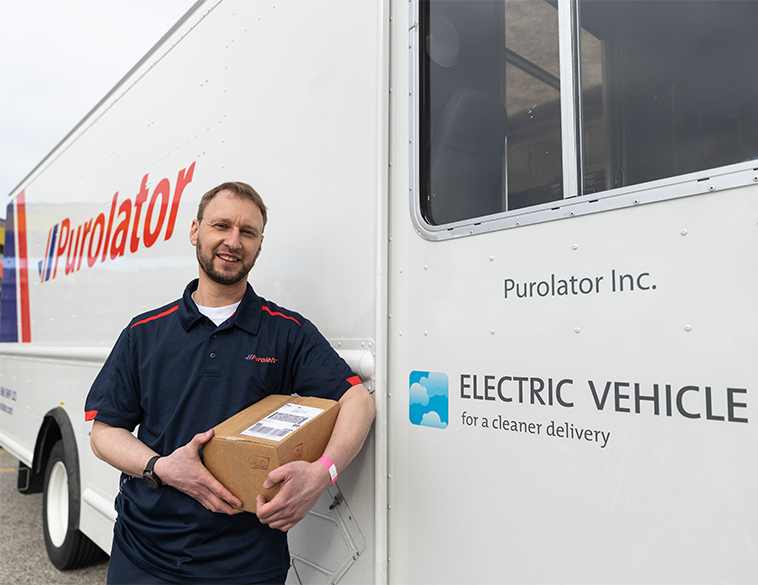Purolator first Canadian courier to launch e-fleet nationally.
As governments and carmakers pledge to be net-zero emissions by at least 2050 – and often before – some fleet companies are doing the same.
Purolator Inc. is making good on its commitment to reach this goal by introducing a fleet of five fully electric curbside-delivery trucks in Vancouver, along with electric-cargo bikes.
The 18-foot curbside trucks have been converted to fully electric by Motiv Power Systems, located in California.
“We’ve had hybrids in our fleet since 2005, so high voltage vehicles aren’t new to us,” says Serge Viola, National Fleet Director at Purolator.
“Our technicians are accustomed to working on high voltage systems.”
All of the vans have an F-59 Ford chassis, 19,500 GVW, with a Morgan Olson curbside body.
“They’re a pickup and delivery vehicle, final-mile,” explains Viola. Motiv was chosen due to their experience and proximity to Vancouver.
Adding more EVs every year
This was part of the Purolator refresh program. “We normally purchase about 10 percent of our fleet every year for our fleet refresh,” says Viola.
“We’re going to be adding more electric vehicles every year, right across the country.”
They’ve been testing small numbers of EVs with different suppliers, and have gotten great feedback from the couriers, the technicians, and excellent reliability. “We plan to implement full electric vehicles going forward,” says Viola.
Some of the benefits include lower maintenance costs and operating costs. Electricity will be less expensive than gasoline and diesel.
There’s less maintenance required, so overall, Viola hopes to achieve 85 percent operating and maintenance cost reduction.
One of the challenges is charging the vehicles.
“We had to be conscious of the range, since they have 127 kWh batteries, putting the range anywhere from 120 to 150 kilometres a day,” says Viola. “But most of our vehicles within the city doing pickup and delivery do less than 100 kilometres a day.”
Five charging stations were installed within the Purolator facility. “We had to be conscious of how much power we had in the facility to power the vehicles,” says Viola. Vehicles are parked overnight, where they are loaded and reloaded.
Chargers were mounted overhead on a reel system, allowing the hose to be pulled down and plugged in. This not only protects the charger from damage or water intrusion but also eliminating tripping hazards. Another charger was installed at the garage for service.
People want to get greener
Drivers are enthusiastic about electric vans. “They like the idea of a greener truck, and being sustainable,” says Viola. “People want to get greener, and to adapt to the new technology.”
There wasn’t much training required for drivers, other than learning to use an incline-hold when stopping on a hill.
Technicians have already been trained on hybrids, so going to a full hybrid was not a big step, and in fact, simpler. It was a matter of knowing where all the components are and how to test them, how to understand the trouble faults.
The electric Purolator van looks almost the same as the others but has a logo on the front and back doors identifying it as an electric vehicle.
That may change since the chassis design is about 50 years old. “It was designed to handle a gas engine, transmission and differential,” says Viola.
“As you get into a fully electric vehicle, you can go to wheel-end motors, you don’t need a differential. You can lower the cargo, which makes it more ergonomically beneficial for the courier.”
A different class of technician
There have not been any fully EV delivery vehicles on the market, although General Motors recently announced an accelerated timeline for the plant and production of their BrightDrop EV600 van.
Why has it taken so long? “The incremental cost made people nervous,” says Viola. “As you get more into EVs and people understand the technology, and you see the batteries are having a long life, they’ll get more comfortable with it.”
Managing the fleet is done with the help of telematics in the vans, so alerts are issued if the battery runs low. “We’ve only used about 30 to 40 percent of the charge on a day’s drive,” says Viola.
When the vehicles are doing last-mile delivery or pickup, there’s a lot of stops and go involved—which works well for an EV’s regenerative braking, so the battery gets charged. “If you were driving city to city, you wouldn’t get the range,” notes Viola.
He notes that younger technicians coming into the industry today are in tune with computers and technology, and love working on EVs versus gas-fired vehicles.
“There’s more electronics, more analytics, more diagnostics than with mechanical repair,” says Viola. “You’re getting a different class of technician today, who’s probably spent their childhood playing video games, so they love technology.”



